We’re Always Connected: An ode to Mega Man Battle Network
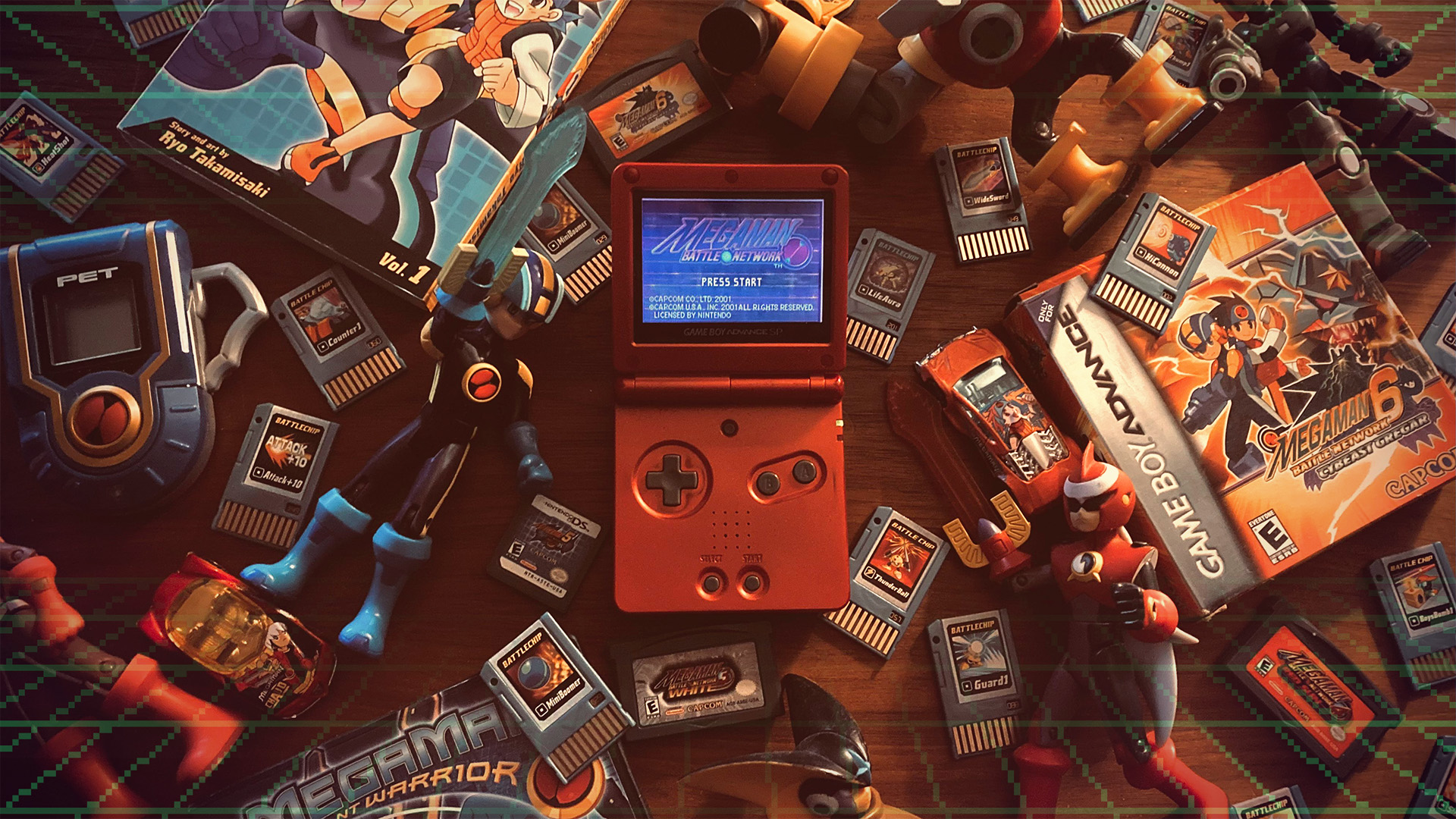
If you paid attention to video game discourse in the ’00s, you may remember a common narrative about Mega Man.
The early sidescrollers had been rightfully enshrined as all-time classics, but there was also this weird reboot they did on the Game Boy Advance called Mega Man Battle Network, designed to cash in on the popularity of series like Pokémon, Yu-Gi-Oh!, and Digimon among kids. Apparently it was popular in Japan for a while, so they flooded the market with sequels and spinoffs. But to the rest of the world that trash just couldn’t hold a candle to the original series, which lacked a new mainline entry in the 12-year gap between 1996's Mega Man 8 and 2008 retro throwback Mega Man 9. I mean, in Battle Network you have to play as some stupid kid who has to go to SCHOOL?! No thank you!
Fast forward to 2023. The newly released Mega Man Battle Network Legacy Collection is the fastest selling Mega Man game in history, selling a million copies in its first two weeks. Why? How? Well, the kids who grew up playing it are all like 30 years old now, so we’re able to explain it more eloquently: Mega Man Battle Network fucking whips ass. It’s whipped ass this whole time. We’ve been trying to tell you.
Minor annoyances aside, these games have aged remarkably well as action RPGs, and their kitschy Y2K era take on the internet only gets more and more charming with age. There’s still nothing quite like it. But in the current media landscape, it’s also left me thinking about how fascinating Battle Network has become as a reboot — one that lovingly homages preceding games while also throwing out tons of their core elements, favoring interesting new ideas over pure nostalgia. For both fans and nonbelievers, I’d like to try and convey what makes these games so special to me.
New players: This article will spoil the twist ending of Mega Man Battle Network 1. Every fan of the series will tell you to skip to 2 or 3 anyway.
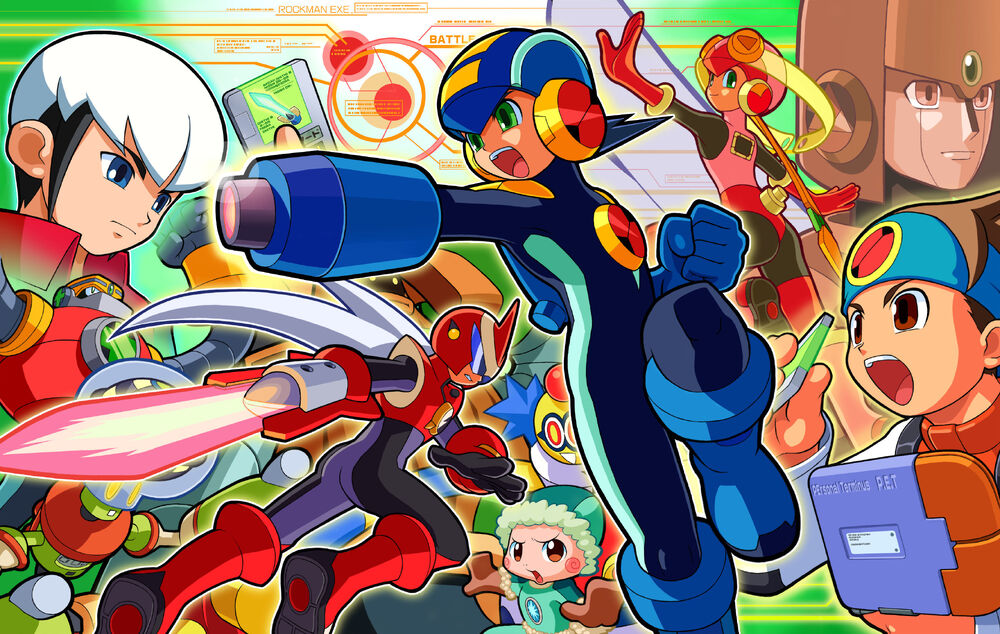
Why are we Battling on this Network?
Mega Man Battle Network (or Battle Network Rockman.EXE in Japan) is an isometric action RPG released by Capcom in 2001 as part of the GBA’s Japanese launch lineup, with five sequels released in the following years. It loosely reinterpreted the original Mega Man series for a new generation, although it was never intended to replace it — at least one Mega Man sidescroller of some kind was still coming out every year at the time. For fans of the classic games, Battle Network imagines an alternate universe where Mega Man’s creator Dr. Thomas Light — renamed Dr. Tadashi Hikari here to fit the Japan-inspired setting— was a pioneer in cyberspace technology, rather than making sentient robots and being surprised when the guy named Bomb Man was used for more than just land development. (Overused joke, I know.)
In the far-off year of 200X, everything is connected to the internet, which in this universe is a whole virtual world of its own. Everyone carries around a cell phone-like device invented by Dr. Hikari called a Personal Terminal, or PET, which houses an AI companion called a Net Navigator. Using your PET, you can “jack in” to various devices and have your NetNavi explore cyberspace. While most NPCs will have generic NetNavis, important characters have custom ones, most of which just so happen to be based on classic Mega Man robots. These battle-ready BonziBuddies are particularly useful due to the fact that the internet is crawling with monstrous computer viruses that can only be deleted via Net Battles.

Players take control of an 11- or 12-year-old Net Battler named Lan Hikari, grandson of Tadashi Hikari, and his NetNavi MegaMan.EXE, who was given to Lan by his super-scientist father. The two have a sort of odd couple dynamic going on. Lan is very much your average kid — he likes soccer, he puts off doing his homework, he seems to wake up late every day of his life, he can have a bit of an ego, and he leaps before he looks. (He also wears rollerblades everywhere he goes.) He’s a good kid, but he’s got a lot of growing up to do. MegaMan, on the other hand, is the more polite, responsible, and intelligent one who tries to keep Lan in line, being the angel on his shoulder. However, like his namesake, MegaMan also has a tendency to push himself extremely hard when others are in peril, disregarding his own well-being in the process and leaving Lan to watch out for him.
Despite exchanging ribbing jokes at each other’s expense, the two have an unbreakable bond that makes them sync up incredibly well in Net Battles. And, as revealed at the end of the first game, this brotherly bond runs deeper than they realize — MegaMan was really created by Lan’s father as the digital revival of Lan’s late twin brother, Hub, who died as an infant due to a rare heart condition. You would perhaps be surprised how rarely this life-changing reveal is referenced in most of the sequels.
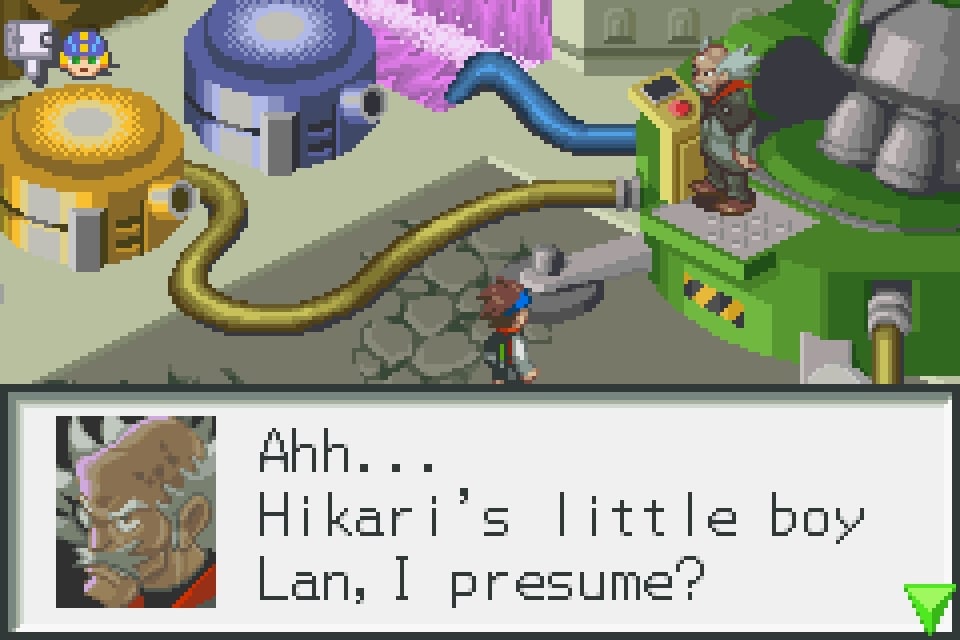
Lan and Hub’s otherwise normal life is frequently interrupted by the efforts of the criminal organization World Three (or WWW for short), led by none other than the villainous Dr. Wily. True to his namesake, Wily wants revenge against the world for ignoring his research in the field of robotics in favor of his former colleague Tadashi Hikari’s work on the internet and Navis. Various colorful characters working for Wily (or other villains) will use their Navis to hack different systems connected to the internet and wreak havoc on the world, ranging in seriousness from “Lan’s house could burn down” to “Skynet is about to launch the nukes.” Lan and his friends inevitably always end up being the ones who have to stop them, because this is a game for children and it wouldn’t be as fun if they let the adults handle it.
Is the writing amazing? Is it even the best writing about the internet I’ve seen in a game? No. It’s no Hypnospace Outlaw. But the characters and world are fun and often funny, and there are strong emotional moments here and there (particularly in the back half of 3). The character writing has more substance than most generations of Pokémon, at the very least, and it should entertain anyone with a soft spot for similar “hobbyani” properties like Yu-Gi-Oh! where the fate of the world revolves around everyone playing a children’s game.
Life on the net
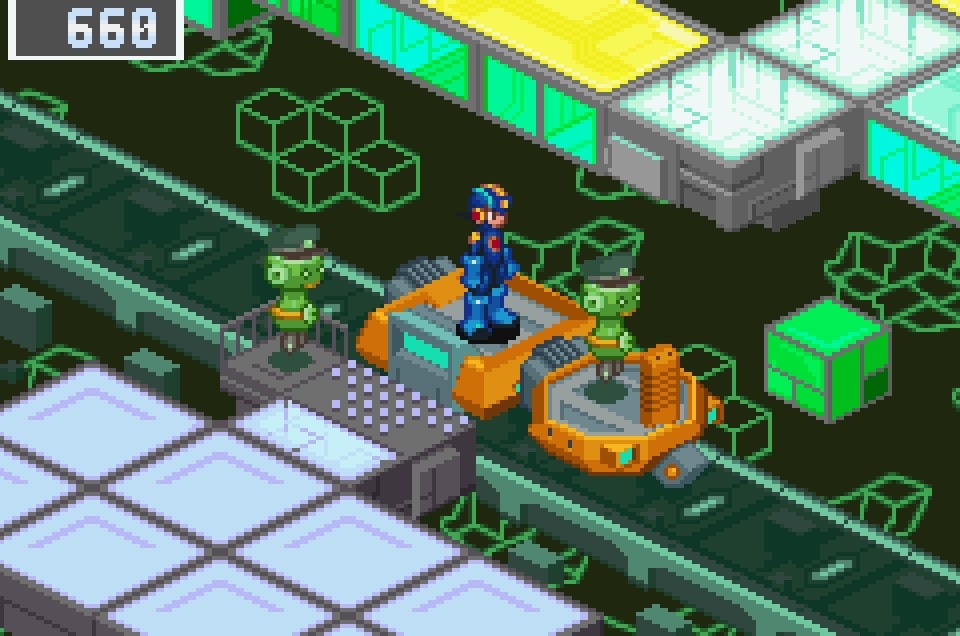
In an era where we’re all chained to a small handful of corporate-owned social media sites, there really is something extremely charming about MMBN’s retro-futuristic vision for the internet.
Every area has an appropriately themed Geocities-ass animated gif background — an aquarium’s control systems will have rotating fish, a power plant will have crackling electricity. Real world landmarks may be represented as holograms in some towns’ corners of the internet. Your neighborhood message board is a literal notice board placed in a town square where Navis congregate. To shop online you have to find a shopkeeper Navi standing behind a retail counter. Shortcut links on your friends’ homepages function as teleporters, which means it’s sometimes quicker to get to certain parts of the net if you log in through your friend’s desktop. And if that’s not enough, you may have to take a little digital tram to get from one town’s network to another’s. Truly, I think we would be happier if we had to make our little guys ride a little virtual train to get from Twitter to YouTube instead of just refreshing the same three sites in a loop.
This charm is perhaps best illustrated by the unsung hero of the series: Mr. Prog. Mr. Progs can be found all over the internet in every game, acting as personifications of simpler programs and usually giving you an excited line or two about their given functions. They are all very stupid and I love them with all my heart.
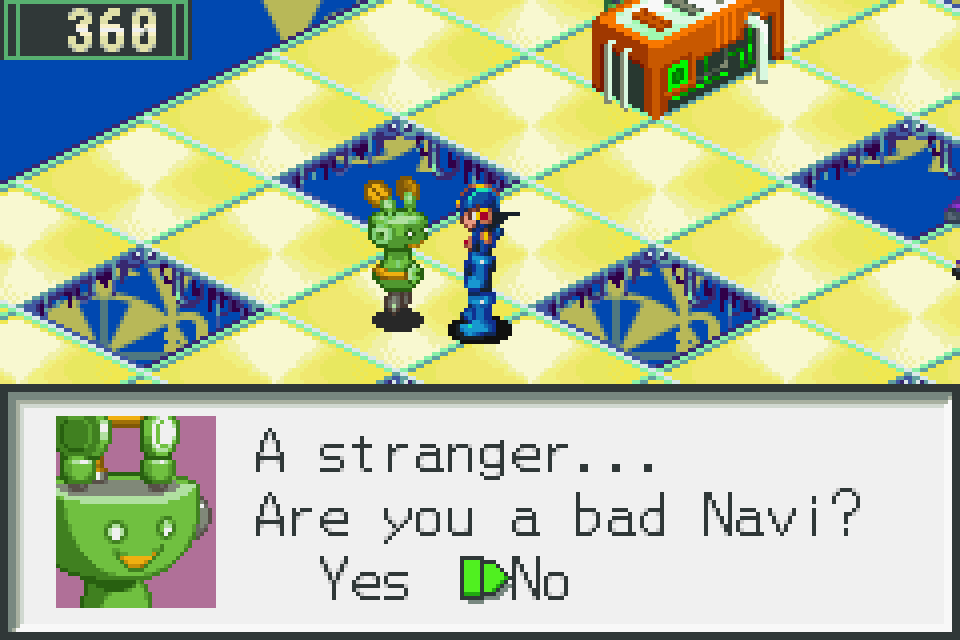
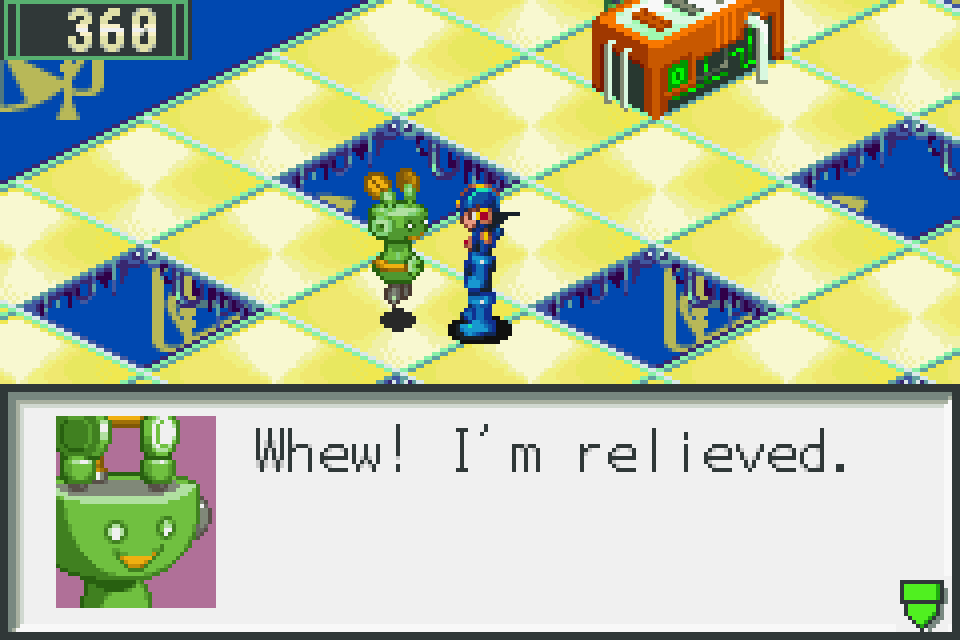
(That one screenshot you may have seen of a Mr. Prog saying “ALL VISITORS, JACK OFF IMMEDIATELY! RUN AWAAAY!” is fake, though. He says “jack out.” I’m sorry to be the bearer of bad news.)
There’s also one aspect of this quaint Y2K-era vision for the internet that’s aged like a fine wine. The idea that every appliance in your home would one day be connected to the internet seemed farcical in 2001, but in the Internet of Things era that’s now a reality for many. If it weren’t for its overall optimistic bent, Battle Network and its constant crises involving wi-fi enabled ovens and self-driving vehicles would almost come off as prescient satire of the era where smart fridges are bugging out and Teslas are constantly self-immolating in peoples’ driveways.
Truly, we live in the lamest version of the near future Battle Network foresaw. I mean, we don’t even have Net Battles.
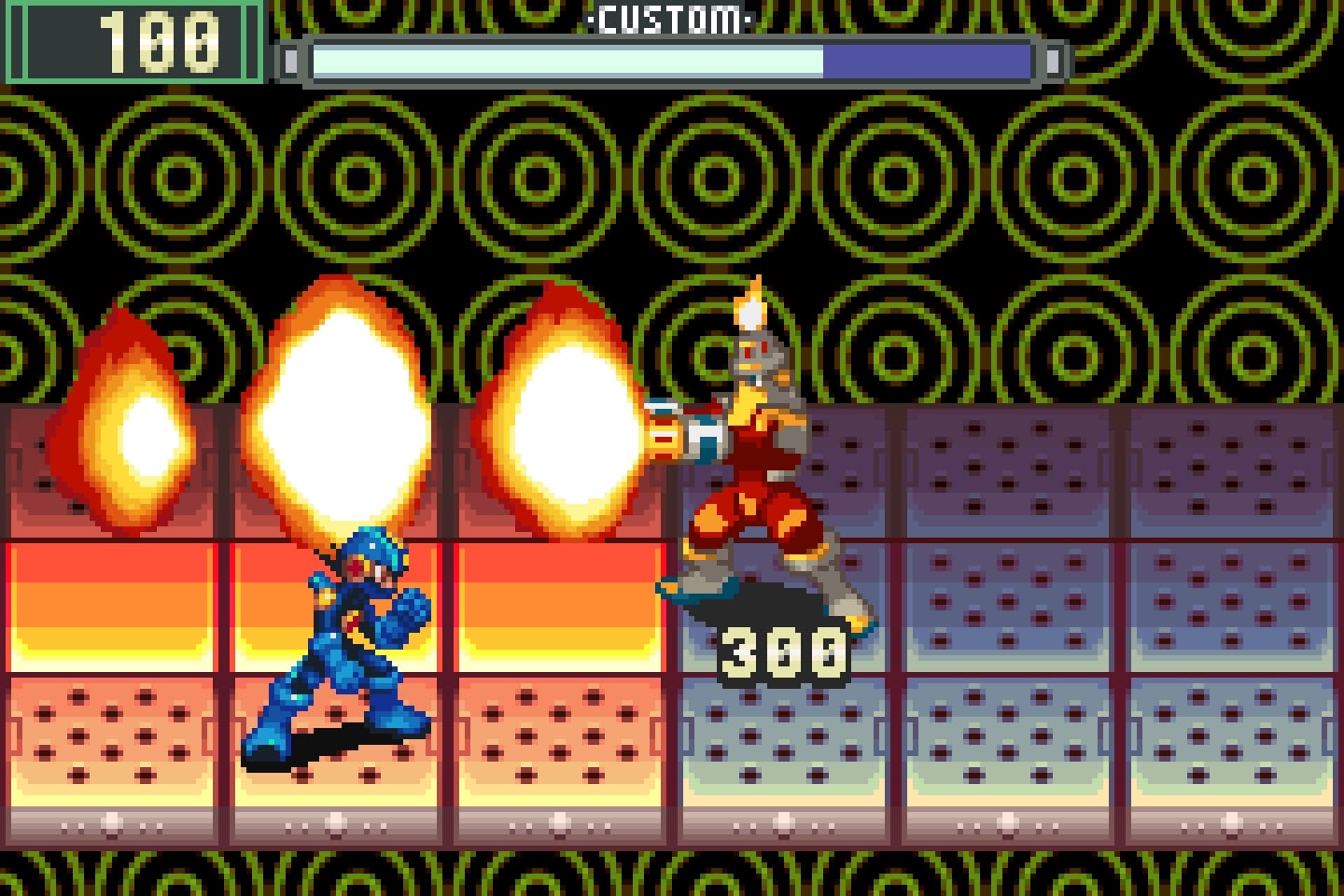
I love this battle system so goddamn much
The main draw of Battle Network is its unique combat system that blends real time action with deck building. Years before Slay the Spire, and even before Kingdom Hearts: Chain of Memories and Metal Gear Acid, it was Battle Network that was innovating in the realm of genre-mixing deck builder gameplay.
All battles take place on a 6x3 grid divided into red panels (your side) and blue panels (the enemies’ side). The speed at which MegaMan and his opponents can warp between panels means that combat can become lightning fast by the end of the story— but even as things speed up, it never becomes a game about pure reflexes. This is an action RPG after all. Strategy is key.
At the start of each battle, the player is presented with five random Battle Chips from their chip folder — basically a deck of 30 trading cards. Each chip comes with a letter code (A through Z), and in a given turn you can either select multiple of the same chip, or you can select different chips with the same code. Battle Network 2 also introduced wildcard chips marked with an asterisk code, which can be used with other types of chips, as well as the ability to mark one chip as your “regular” chip that you always draw first. (These small changes make the sequels infinitely more enjoyable than the first game.) You then enter real time combat, able to use the chips you selected in sequence while dodging enemy attacks. After about ten seconds, your custom gauge at the top of the screen will fill up and allow you to pause the action and select more chips. If necessary, you also have your chargeable Mega Buster to do some damage, but chips are the real star of the show.
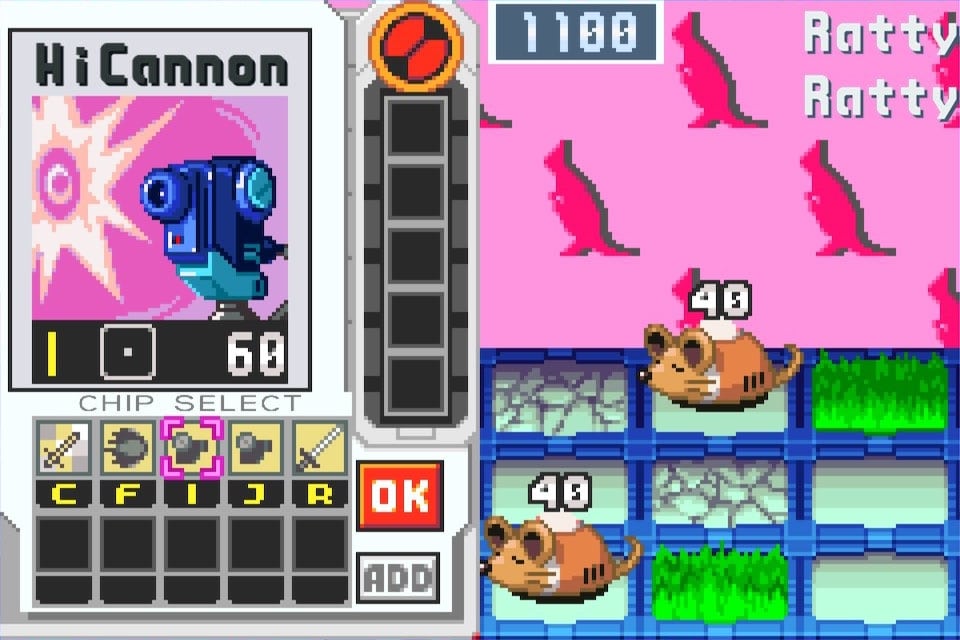
There are hundreds of different Battle Chips in each game. Some are straightforward projectile attacks. Some hit a specific pattern of panels. Some are melee weapons with varying ranges. Some will be boomerangs that circle the battlefield, bombs that are lobbed three panels ahead, or homing projectiles. Some will heal you. Some are shields that deflect enemy attacks. Some can steal enemy panels so that you can move in closer or restrict their movement. Some alter the types of panels on the field. There are shockwaves, yo-yos, time bombs, giant fans, geysers, charging sheep, cactus balls, chess piece minions, corn grenades… I could go on and on. There are even secret chip combos called Program Advances that give you various super attacks. There are seemingly endless possibilities to customize your loadout to your liking.
This freedom also means these games are begging for you to break them in fun ways. Many bosses can be totally cheesed with the right strategy. In my recent playthrough of Battle Network 3, the semi-randomized Style Change system granted my MegaMan a fire-themed form that made his charged shot a flamethrower and made him immune to damage from lava panels. Naturally, I paired this with a rare Battle Chip that turned the whole battlefield into lava. When it came time to fight PlantMan, who’s weak to fire damage, I simply watched as he helplessly jumped from lava panel to lava panel, losing 10% of his health and getting stunned each time, and then used my charged shot to finish him off. I barely saw any of his abilities. I used one Battle Chip. It ruled.
In practice, Net Battles become a delicious cycle of planning and execution. You look over the chips drawn from your carefully constructed folder, anticipate your enemies’ moves, and then try your best to execute on that plan. At the end of each battle you’re ranked based on your speed and efficiency, and when you get good at fighting and building the right folders the actual combat can end in the blink of an eye — it’s common to see groups of viruses go down in under a second or two of combat.
(The speed of battles, as well as the randomness of your Battle Chip selection, helps make the constant random encounters in these games less annoying than they would otherwise be, although there are still items and upgrades that can disable encounters as needed. Starting in 2, you can also flee from any random encounter with no penalty.)
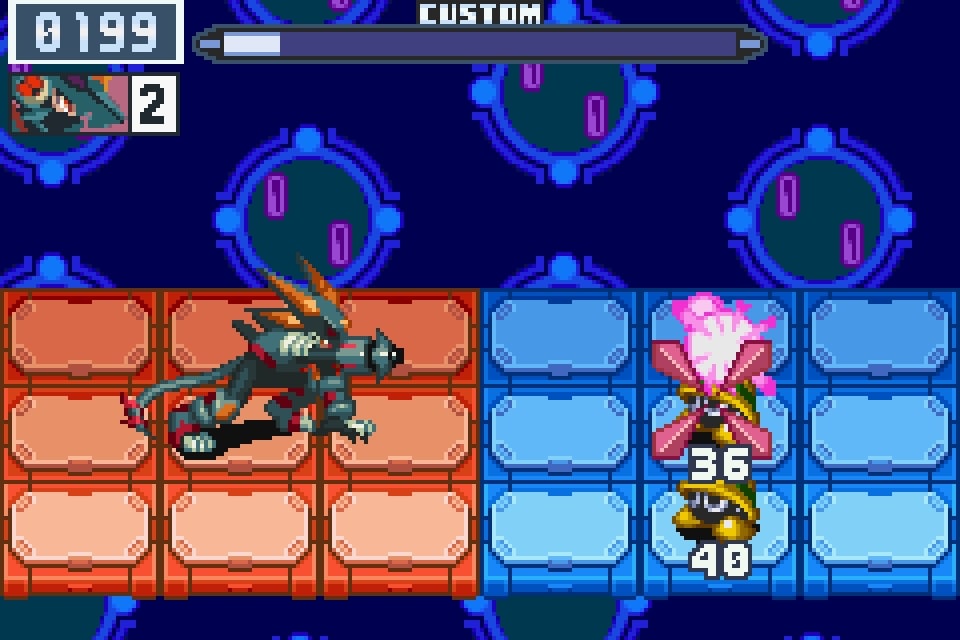
As the series progressed, more toys were added to play around with —a Navi Customizer to tweak MegaMan’s attributes, a counter system, various transformations that change MegaMan’s Buster shot and elemental affinity, opportunities to play as other Navis, etc. This culminated in the beautiful chaos of Battle Network 6, in which MegaMan can turn into a demonic train furry. But the core of the combat remained the same throughout. For reviewers at the time, these similar annual releases led to series fatigue and ever-decreasing review scores. It’s understandable. But as a fan, it’s hard to complain about having six whole games in that style to go back to when there’s nothing else quite like it, even in this era where we’re starting to see indie spiritual successors like One Step From Eden, EndCycle VS, and Hero.EXE.
While I’ve never really touched this aspect of the series, the combat also shines in multiplayer, with two players being able to pit their MegaMen against each other. Capcom used to hold official tournaments when the series was new, but in the years since there’s remained a passionate grassroots competitive scene around the world. Multiplayer should appeal to fans of fighting games who enjoy mind games and trying to read your opponent’s next three moves. With the release of the Legacy Collection and the addition of online play, I’m sure that scene is only going to grow bigger and bigger. (If you’re interested in the competitive scene, I would recommend this video by Akshon Esports about its history.)
Truly, at the very least, Battle Network deserves respect for creating such a unique and engaging battle system. It would’ve been so easy for them to just make a Pokémon clone with robots and call it a day, but instead they used the trends of the time as inspiration for something not quite like anything else. It’s in conversation with those trends, rather than just copying them.
It might play nothing like the Mega Man you grew up with, but that doesn’t mean it isn’t one hell of a game in its own right.
Building off of the past without just rebuilding it
In the current media landscape, a reimagining as creative as Battle Network is rare — and successful ones are even rarer.
You just can’t change the fundamentals of a beloved series without causing widespread fandom outrage. Some will recall the exaggerated response to the blue arms and sports tape in Sonic Boom, a reboot that otherwise stuck much closer to its roots than MMBN did, and things haven’t gotten any better in the decade since. Today, right wing grifters on YouTube make bank screaming that their childhood has been ruined anytime a popular franchise makes even the slightest changes. Corporations, too, are primarily concerned with sticking with what works about their big name IPs and appealing to nostalgia, rather than taking risks on too many new ideas — even new ideas attached to established names. We’re in the age where most AAA games are getting more and more samey, and Disney is pumping out multiple near shot-for-shot live action remakes a year and making billions in the process. Familiarity is king.
As this article proves, I am not immune to nostalgia. But when pure, unfiltered nostalgia is increasingly the only thing that’s allowed to have a budget, you don’t get interesting new takes like Battle Network. At most, you might get an adaptation into a new medium that takes some liberties… like, say, the most recent attempt to reboot classic Mega Man for a new generation of kids: the 2018 animated series Mega Man: Fully Charged.
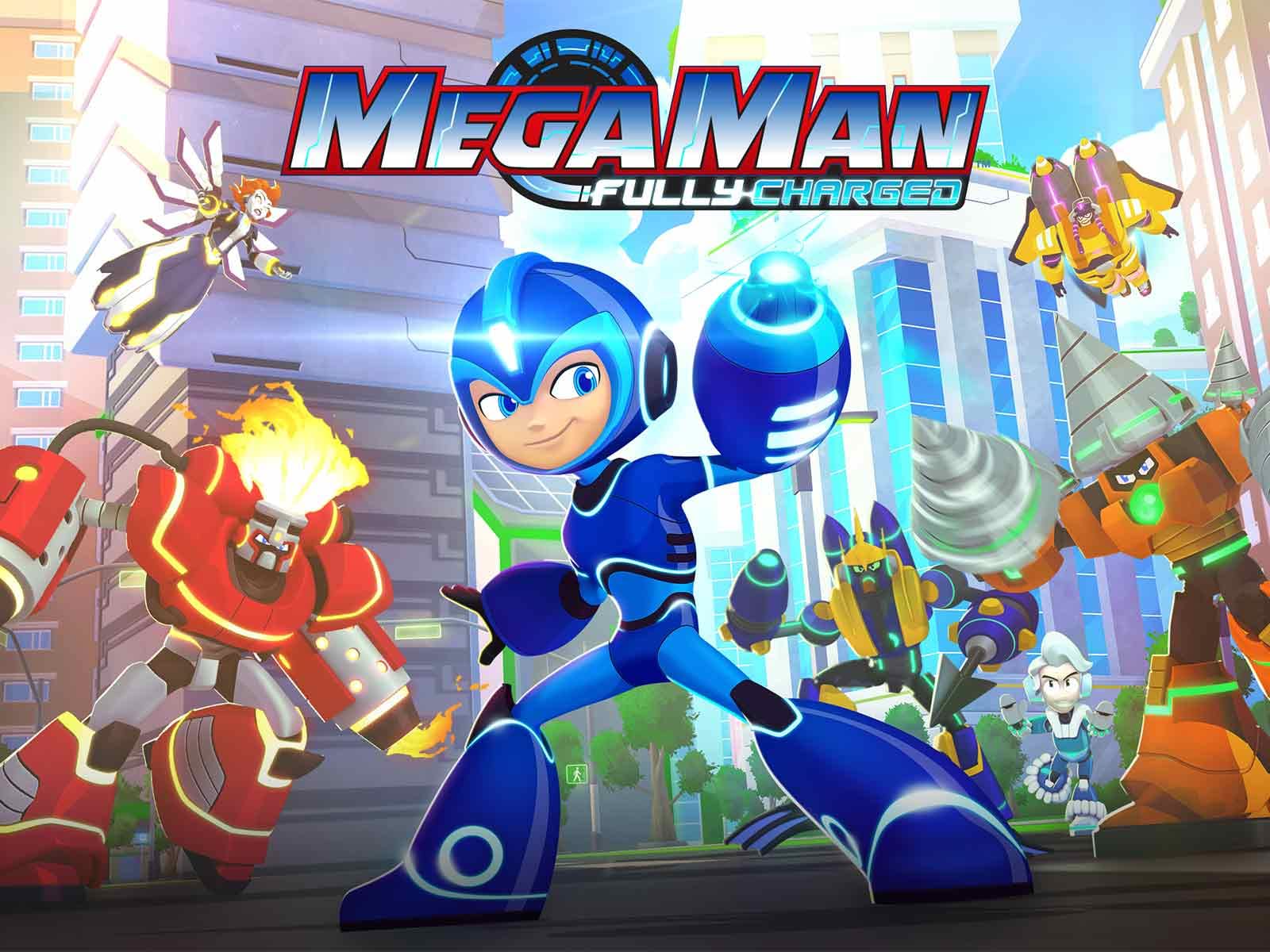
While it took some liberties with the source material, Fully Charged was still a show about a super advanced robot boy created by a scientist named Dr. Light who dons a blue suit of armor to become Mega Man. The surface details of his design have changed to be more “modern” (he glows like a gamer keyboard so you know it’s The Future), but his silhouette is identical. He fights rogue Robot Masters like Guts Man and Wood Man with his Mega Buster, copying their abilities along the way. He also has a sister, a dog named Rush who can transform into vehicles for him to ride around on, and a long lost brother who’s been coerced into being his rival by the main villain.
Even though it was aimed squarely at kids with no attachment to Mega Man beyond maybe recognizing him from Smash Bros., the creators were constantly reassuring adult fans that it would mostly be the same Mega Man they knew and loved, just with a new coat of paint. Because that’s pretty much what you have to do these days, lest you face the wrath of your loyal fans. Trying to do something new and different is a very hard sell.
Anyway, you’ll never guess what show still faced the wrath of the loyal fans.
For the older fans they tried to court, it wasn’t the 100% faithful Mega Man cartoon they wanted. Many wrote it off from the start simply because the character designs were tweaked. For the Gen Alpha target audience, it was a generic kids’ superhero show that aired at like 6 a.m., designed to sell them on 8-bit platformers from when their parents were kids. (Fully Charged didn’t have a game — it was ostensibly advertising the Legacy Collections.) Aside from a few interesting story ideas that were later expanded upon in a surprisingly cool 2019 comic miniseries, the ways in which it differed from the source material were mostly just efforts to copy the formula of previous Man of Action productions like Ben 10. It had its moments, but any true creativity was heavily watered down in the single season we got before the show was canceled.
Battle Network was a very different beast. Rather than merely aping as many of the nostalgic surface level elements of Mega Man as possible while shifting some details around, Battle Network broke the original Mega Man down to the bare essentials, then built something new from those pieces. Something that was unafraid to drastically change the premise, characters, aesthetics, and gameplay, but retained the essential spirit of the series.
Let’s identify some of those core elements that comprise that spirit.
Remixing the spirit of Mega Man
1. Anime and manga influence
Mega Man has always drawn very liberally from its anime and manga inspirations. The classic series “borrowed” much of its identity from Astro Boy, as well as other series like Cyborg 009. For my money, Mega Man X’s somewhat darker storytelling learned some lessons from Gundam (one of the games literally revolves around a colony drop), but a certain Twitter thread also makes a compelling argument about there being a ton of Samurai Pizza Cats in there. Battle Network’s dev team reportedly watched Mamoru Hosoda’s Digimon Adventure: Our War Game! as homework during the final months of development, and they also looked to the character design work of Shaman King. (Naturally, they watched The Matrix, too.)
2. A futuristic setting
As a sci-fi series, the story revolves around fictional technology. Instead of robots, this time it’s a more fantastical version of the internet, something that kids would find relatable. While misuse of this technology leads to conflict, at the end of the day this vision of the future is going to be more optimistic than pessimistic.
3. Mega Man himself
The hero still has to be a little blue guy with a Mega Buster and a vertical stripe on his helmet. He doesn’t have to be a robot, but the personality is important — the true Mega Man is fairly serious, helpful, and selfless to a fault, originally intended primarily as a helper before circumstances push him into becoming a hero. He’s a little bit of a dweeb, but putting that dweeb up against cooler, seemingly stronger characters and having him fight for what’s right makes him cool.
There’s also an underlying air of sadness to him in some way. Instead of being forced to fight his reprogrammed brethren and longing for a peaceful future like the original Mega Man, MegaMan.EXE has his backstory as Hub, and a sense of longing from the fact that these two brothers can’t exist in the same physical space.
4. Simple but challenging gameplay
The specific genre is less important here than this broad design ethos. The action-based gameplay is simple to learn but hard to master. The challenges the player is presented with can largely be overcome by learning to recognize boss patterns and figuring out the right tools for the job. This strategic element is given greater focus over pure reflexes in Battle Network in an attempt to appeal to a broader audience compared to the sidescrollers, which were growing more and more niche at the time.
5. Mega Man gains stronger weapons from the opponents he defeats
This concept is greatly expanded upon via Battle Chips. Common virus enemies can drop chips that let MegaMan replicate their attacks, while boss NetNavis drop chips that let you summon them for time-freezing super attacks. As in the original games, you generally have a lot of freedom in choosing what weapons to use where, but knowing the right weapons to use at the right time and taking advantage of rock-paper-scissors-style weaknesses is key.
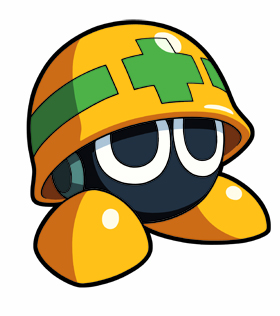
6. Mets
You gotta have some Mets. The Mettaur virus appears as the first enemy you learn how to fight in all six games. The rest of the viruses, however, all have totally new designs, unrelated to anything that came before.
And, of course…
7. The music
His name is Rockman, after all. The music has to rock. And while it would have been easy to remix all the iconic tunes of the past, the mainline Battle Network games instead feature wholly original soundtracks that can easily stand toe to toe with the rest of the franchise.
The music team consisted of Akari Kaida (Mega Man & Bass, Breath of Fire III, Okami) on 1 and 5; Yoshino Aoki (Breath of Fire III and IV, Final Fantasy XV) on 2, 3, and 6; and recurring Mega Man contributor Toshihiko Horiyama (Apollo Justice: Ace Attorney) filling in on 4. Rather than fight with the infamous GBA sound chip by trying to make something that sounded like a live band (or, god forbid, a whole orchestra), Kaida embraced her limitations and established a more chiptune-led sound with sampled harmonies, percussion, and orchestra hits as supporting elements. This played much nicer with the tinny hardware without feeling too compromised in audio quality, and it fit the digital setting like a glove.
I’ll let a few of my favorite tracks speak for themselves:
“Fire Field” — FireMan’s stage, Battle Network 1
“Shooting Enemy” — Battle theme, Battle Network 3
“Navi Customizer” — Navi Customizer, Battle Network 5
Again, the first game was a launch title for the GBA, which only makes Kaida’s immediate home run even more impressive.
Many other elements that you might expect to see in a Mega Man game were liberally cut. A stage select with eight bosses to choose from? Out. People had been getting tired of that formula. Does Mega Man have his faithful canine companion, Rush? A version of him does technically exist… but it’s really just a random dog-themed virus. What about E-Tanks, Sniper Joes, and disappearing block puzzles? Nope. Not all of the old iconography needed to return. There needed to be ample room for new ideas, and to riff on the old material instead of just repeating it. The entire point was for the series to evolve.
The missing link
There is an extremely important missing evolutionary link between Mega Man and Battle Network, though: the cult classic 3D action adventure game Mega Man Legends, which had previously expanded the definition of what “Mega Man” could mean.
The Battle Network team grew out of the Legends team at Capcom Production Studios 2. Initial key members were fresh off work on 1999 spinoff The Misadventures of Tron Bonne, while others joined later after completing Legends 2 in 2000. To this day, the public face of the dev team is series writer Masakazu Eguchi, who got his start as the script writer for Legends 2.
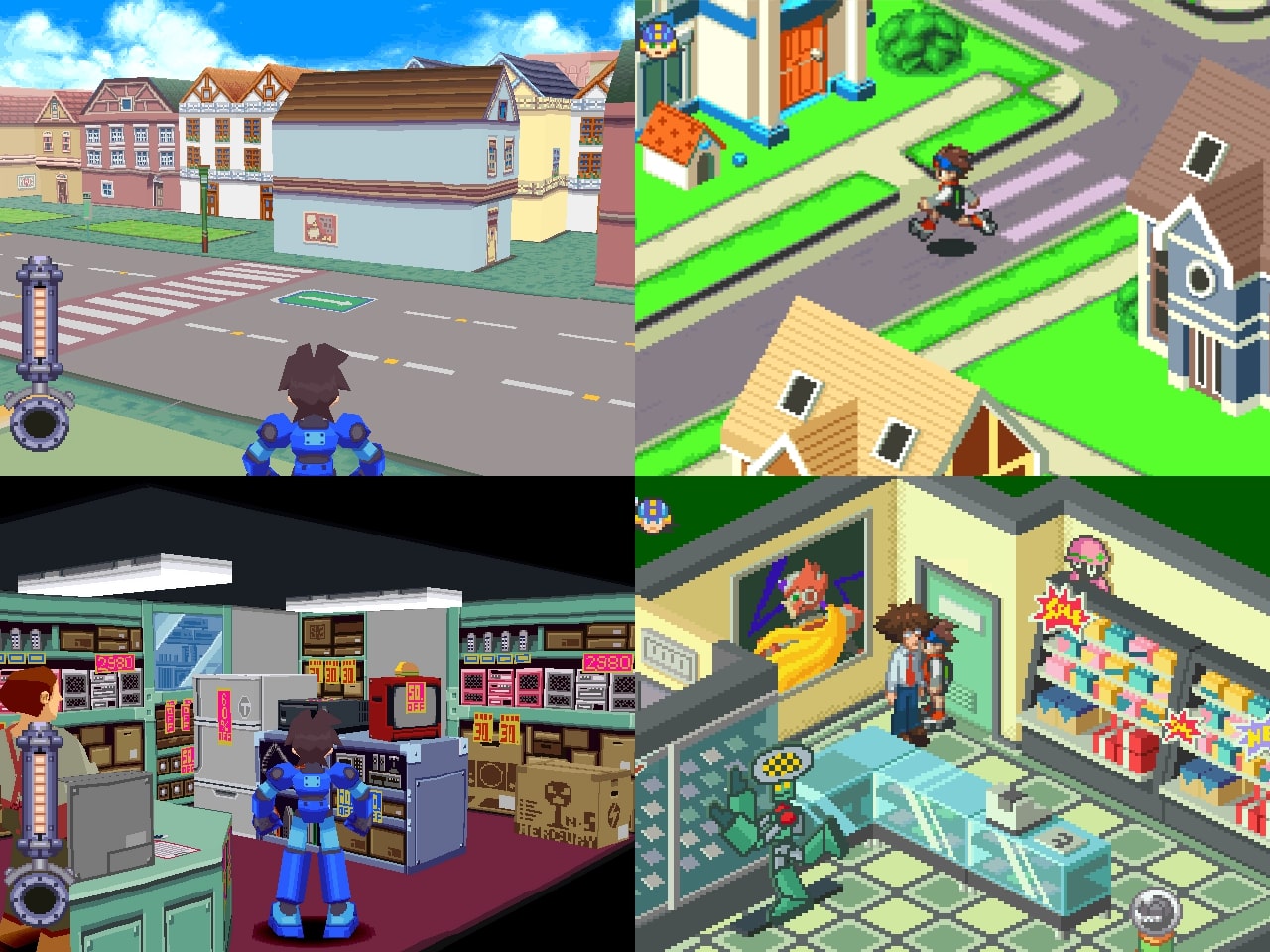
When you know about this connection, a lot of things in Battle Network start to make more sense. The art direction, the shift towards RPG elements, the way the Mega Buster now has multiple different attributes that can be upgraded. They even share Zenny as a currency. To me, the divide between the real world and the cyber world in Battle Network evokes the way the human-populated surface world of Kattelox Island contains scattered entrances to the maze-like network of underground ruins where most of the action takes place in Legends 1. While it’s rarely framed as such, Battle Network is very much an evolution of Legends.
As a nod to their previous work, the first few Battle Network games are filled with overt references to Legends. One of Lan’s best friends, the genius rich girl Yai who skipped two grades, is an expy of a minor NPC in Legends 2 — and her Navi, Glyde, is based loosely on the character of the same name introduced in The Misadventures of Tron Bonne. Various real world locations will also feature posters and toys of Legends characters like the Servbots and Data (and sometimes classic Mega Man and Mega Man X characters), with the implication being that they exist as works of fiction in this universe.
Of course, the English translators didn’t always get the memo that these were references.
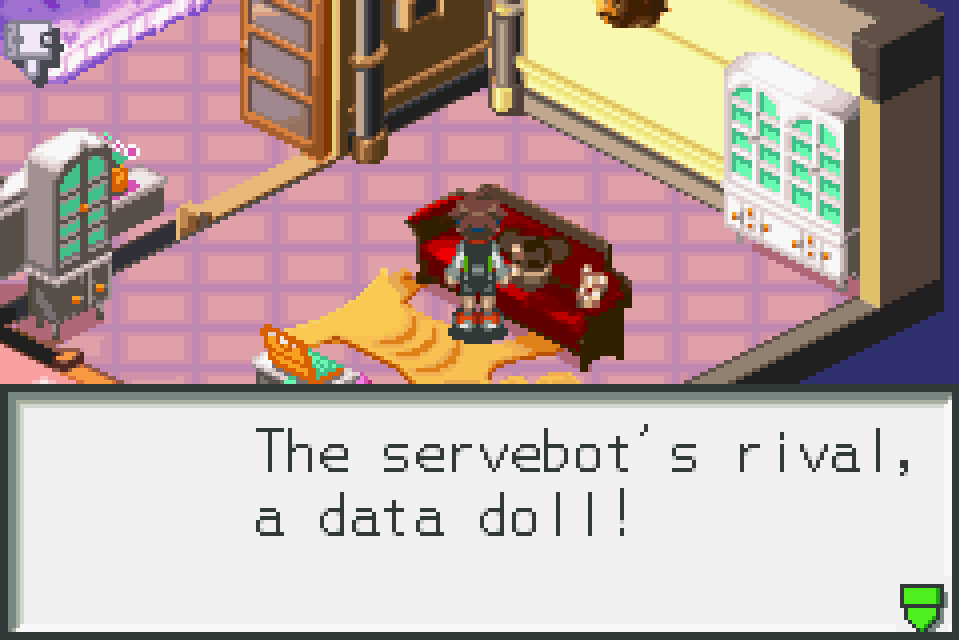
And like Legends, Battle Network also has some really sick character designs.
NetNavis rule
As mentioned, a majority of Navis are based on existing Mega Man characters, although the character design vocabulary here is much broader than what was allowed in classic Mega Man. Not every character has to have the same big, stompy boots and metal undies — but at the same time, not every character has to have the streamlined bodysuit look of MegaMan.EXE, either.
Some Navis hew very close to their original series counterparts with relatively minor changes, like CutMan, AirMan, and QuickMan. The proportions may be adjusted to create a more unique silhouette, like with SkullMan, but the important details are mostly the same. Because this isn’t a hard rule, it feels like an intentional choice when it happens, usually to retain the look of a particularly iconic Robot Master.
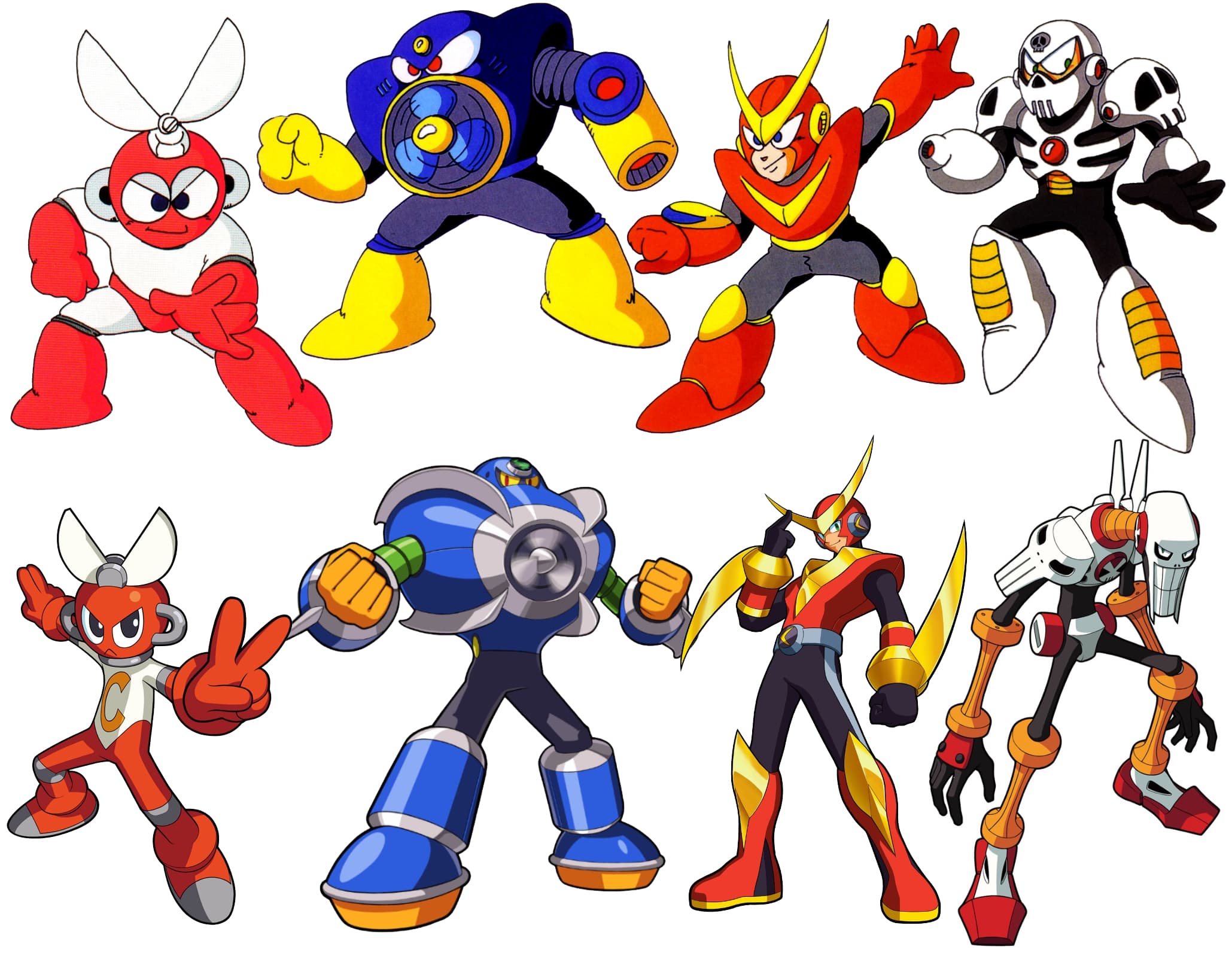
Like, no disrespect towards the classic designs. I love ‘em. There’s an undeniable appeal to their uniform aesthetic. But I love how much the varied Navi designs are able to bring out everyone’s personality at a glance. You get them immediately. QuickMan LOOKS fast now. SkullMan LOOKS skeletal and scary. CutMan LOOKS like a cute little guy.
Then there are Navis who are recognizable without sticking quite so close to their original designs. This includes much of the main cast.
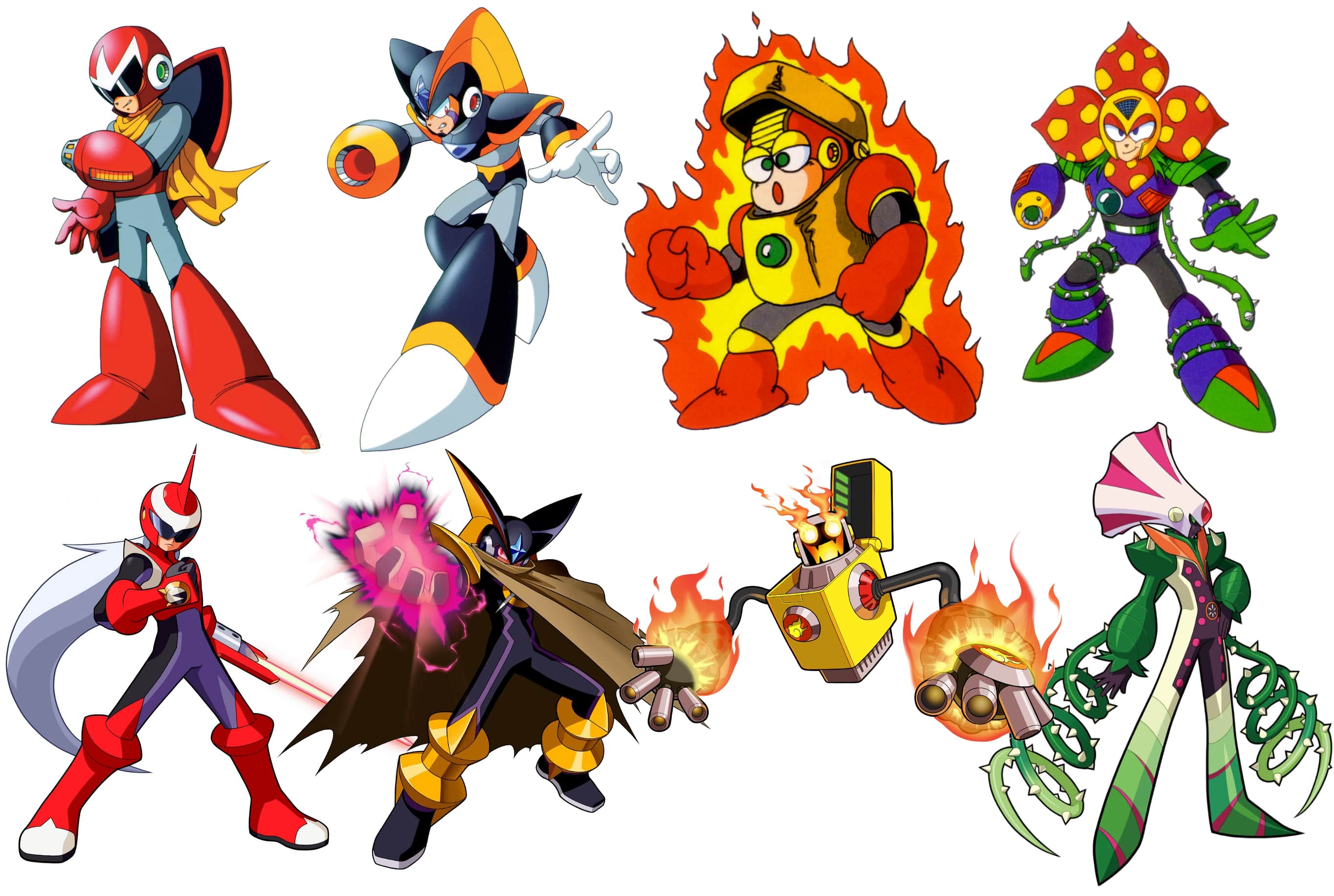
ProtoMan.EXE has the color scheme and shades of his predecessor, but he looks much sleeker, and he also borrows a long ponytail and laser sword from Mega Man X’s Zero (who he’s arguably closer to in terms of personality). Bass.EXE has the trademark helmet fins, but his role as a wandering rogue Navi with no human operator means his bulkier armor is traded for a scarred chest and a tattered cloak. Why would a digital NetNavi need a cloak? Who cares. Rule of cool. Importantly, both retain proportions close to MegaMan’s, letting them remain something of a trio, design-wise.
A good deal of boss Navis get this treatment as well. HeatMan retains his signature yellow Zippo lighter body, but he’s given more of a crazed pyromanic look with flaming eyes and hands, and he hovers instead of having legs. PlantMan retains the general idea of his original design with a flower-shaped head and dangling vines coming off his back, but he has a more graceful design inspired by a morning glory rather than a Rafflesia. I also just love the leek-inspired gradient of stripes going down his legs.
And then there are the redesigns that take the core theme and go in a totally different direction with it.
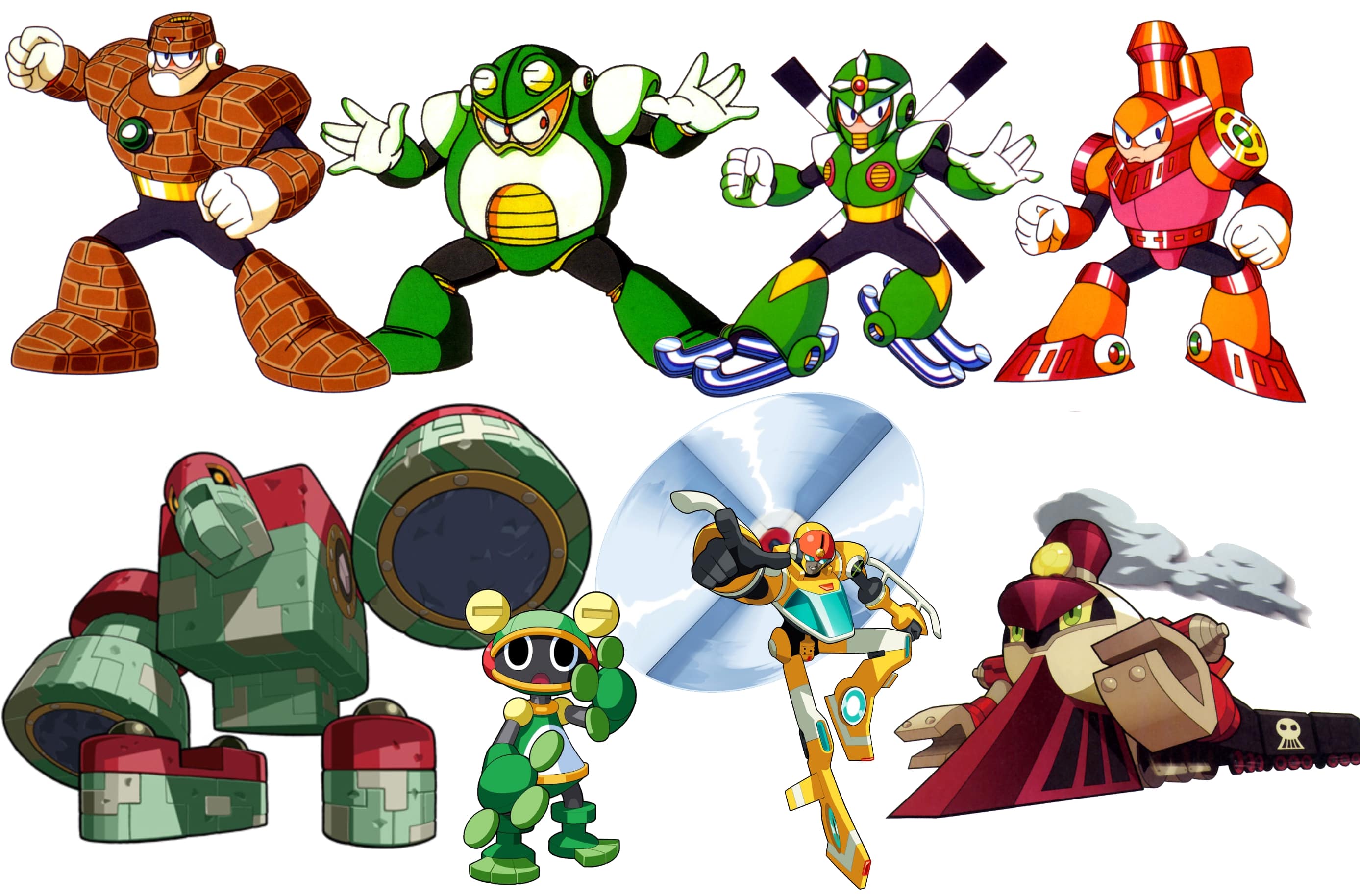
Where the original Stone Man just looked like a Guts Man reskin, StoneMan.EXE gets to be a gigantic, blocky stone golem. ToadMan goes from being a big, round bruiser to a cute little mascot character belonging to a peppy young news reporter named Ribitta. GyroMan takes a green helicopter-themed robot and turns him into a straight up Transformer with a lively yellow color scheme. And one of my personal favorites: ChargeMan takes a train-themed humanoid robot and makes him… a train.
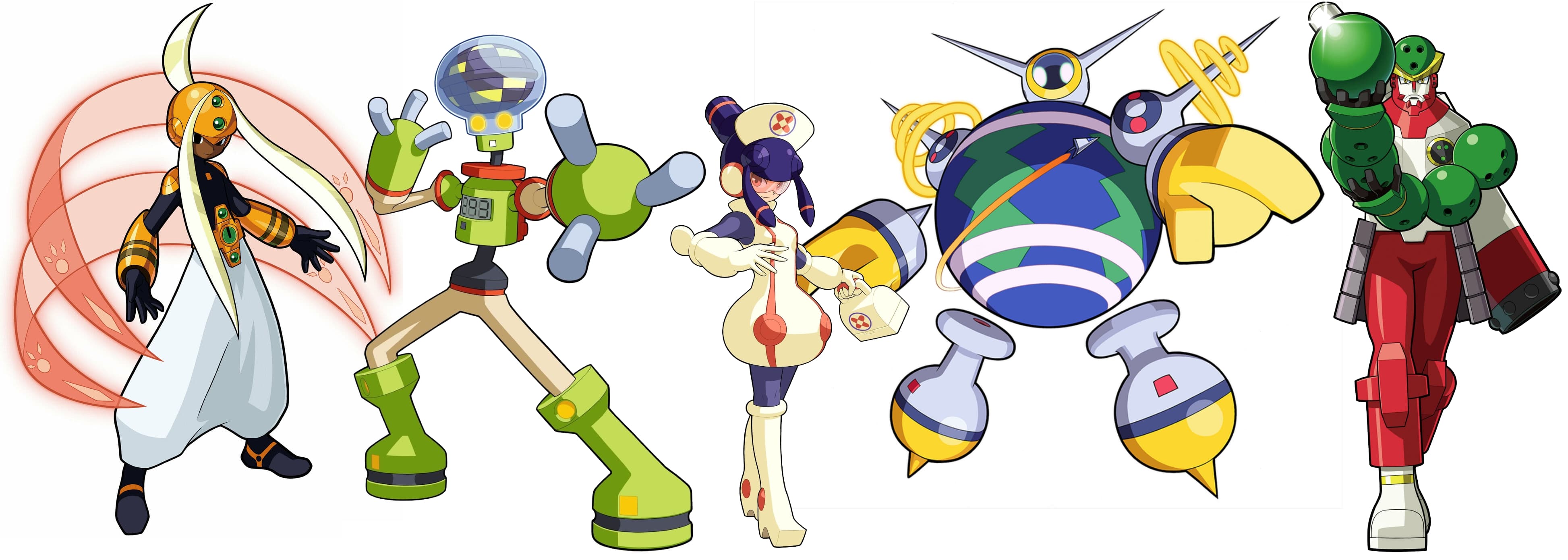
Of course, there are also a lot of Navis that have no prior counterparts whatsoever, like canonical nonbinary icon Serenade, beloved turbo nerd NumberMan, battle nurse Meddy, or the spherical PlanetMan. But none of them can compare to the sheer audacity of BowlMan, a bowling-themed samurai with arms made of bowling balls and a giant pin-shaped cannon. Like many of the classic Robot Masters, he was the result of a boss design contest, and he is truly one of the greatest character designs ever made.
To prevent this article from getting even longer, I won’t be devoting nine more paragraphs to the designs of the Navis’ human operators, but the way Navis and their human counterparts play off of each other is another fun part of the series. They might be extremely alike in demeanor and aesthetic, they might form a logical duo like a princess and her knight, or they might be total opposites. One of the simple joys of the series is encountering a supposedly innocuous NPC with a unique design and trying to guess what their Navi will be like once they’re inevitably revealed to be a Net Battler.
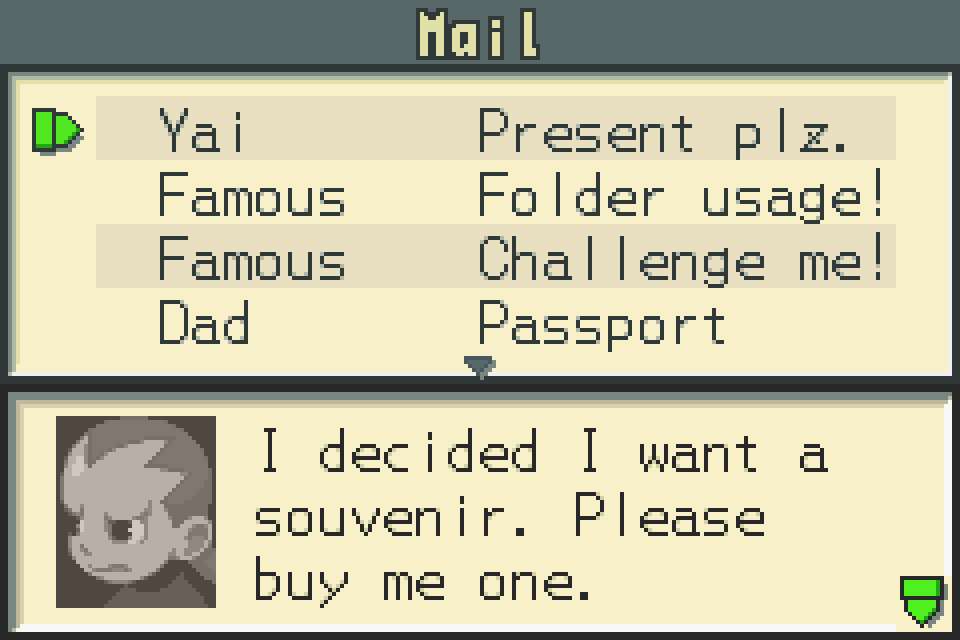
Smart design choices
Amidst all this glowing praise for the series, I will admit that these games are far from perfect. Aside from the inherent repetition of six games that mostly play the same, there tends to be padding in the form of forced backtracking, the random encounters can get tiring, internet areas can get a little too maze-like in design, story objectives can sometimes be unclear, and the English scripts can be a little messy (particularly 4’s, which is riddled with constant typos and errors). But these are mostly problems that any fan of old JRPGs should be used to.
In spite of all this, I genuinely do believe that these are well-made games, particularly for their time. I’d like to highlight some random design choices that I liked upon returning to the series. While a lot of this will sound really basic to players used to the countless quality of life features seen in modern RPGs, for a handheld RPG from the ’00s these are a godsend:
- Damn near every unique object in the real world seems to have bespoke flavor text attached to it. Given some of these objects will secretly contain internet ports, this helps encourage the player to inspect everything.
- Nearly every NPC in the world also gets new dialogue after every major story beat to reflect current events.
- Your PET has an email inbox, which sort of serves as a clever in-universe justification for a quest log. Characters will occasionally tell you what you need to do next via email. Even more useful: pressing L at any point outside of battle will give you a hint about what you’re supposed to be doing.
- (Later games also offer a “Humor” program that makes MegaMan crack jokes when you press L instead of giving hints.)
- You can save anywhere outside of battle. That might sound like nothing, but tons of big name GBA games used save points and made up for it with some sort of “sleep mode” that turned off the screen and speakers.
- There’s no need for inns or Pokémon Centers. On top of healing items and chips, MegaMan is automatically healed when you exit the internet. The ability to jack out also means that there’s no need for escape ropes or similar items — you can just press R to leave a dungeon.
- Instead of treasure chests, the internet is littered with gem-shaped Mystery Data. Blue ones and locked purple ones give specific one-time rewards, but green ones spawn in random spots and give random loot anytime you return to an area. This makes both backtracking and grinding for money a bit less painful.
Again, while many perceived these games as cheap, low-effort cash grabs, this couldn’t be further from the truth. Yes, they iterate on the same gameplay ideas over and over, and many art assets are recycled across the series. But so much thought and care was put into making them genuinely good action RPGs. Coming back as an adult with greater perspective on game design has only made me appreciate them in new ways.
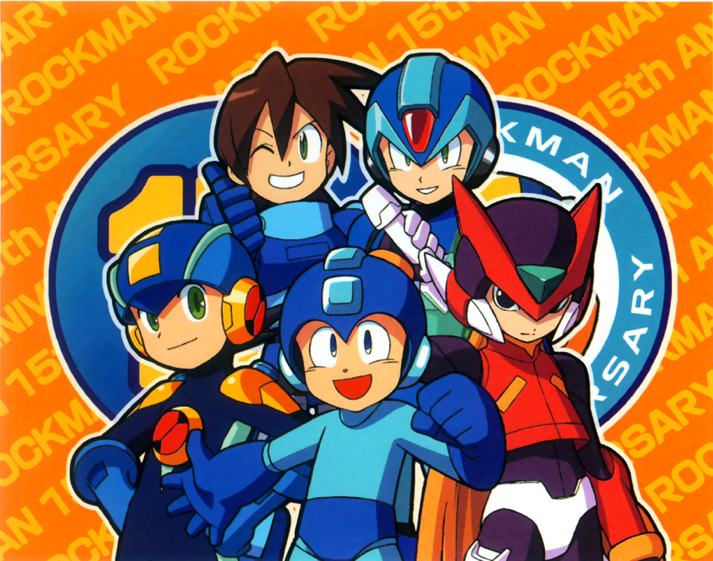
Growing up in the Mega Man bubble
When people claim that Battle Network flopped in the west, it makes me feel like I grew up in an alternate universe. Battle Network was everywhere at the time.
Sure, it never reached Pokémon levels of market saturation, but is that really a fair comparison for anything? We had the games. We had like 100 episodes of the anime airing Saturday mornings on Kids WB, right after Yu-Gi-Oh! You could go into any Waldenbooks and pick up the manga at a time when manga based on video games being released in English was NOT a guarantee. There was, predictably, a trading card game. Just about every store that sold toys had a shelf full of Mattel’s action figures and roleplay weapons based on the anime. There were Hot Wheels with the characters printed on them. And, of course, we got the Tamagotchi-like physical version of the PET and its dozens and dozens of plastic Battle Chips. (I could never really get mine to work right, but it’s a cherished item in my collection nonetheless.) With such a huge marketing push, it’s no wonder it was the thing that got kids in the ’00s to pay attention to Mega Man.
My first Mega Man game was Mega Man Battle Network 3: White. I still remember picking it up with my allowance at the Sam’s Club in my hometown of Gainesville, Florida 20 years ago. I don’t remember what exactly spurred me to buy it — living out in rural Florida, our only option for TV was a satellite package that didn’t have the major networks, so it’s not like I was watching the anime. If I had to guess, it might have been that commercial for the franchise’s 15th anniversary where the kid says “he’s the Blue Bomber, he’s the best.” (I cannot for the life of me find an upload of this.)
Regardless of what inspired me to buy it, I was instantly enthralled by this world where kids could lead double lives fighting evil on the internet, as well as the unique battle system. For a while I’d just run through ACDC Town’s internet and fight the first three virus types over and over. Maybe I’d feel spicy and start a new file from scratch. Eventually I figured out how to move new Battle Chips into my folder, as well as how to actually progress the story through the FlashMan scenario, although I never beat it — or even got close. This didn’t lessen my love for it. The thought of how much more Game there was in that cartridge—the rest of the story, a way to unlock those pesky WWW gates and get the treasure behind them, the spooky Undernet — gave it this air of mystique. It was a game that kept on giving.
Over the next few years I would scoop up every piece of Mega Man-related media I could get my hands on. My first classic series game was the unpopular GBA port of Mega Man & Bass. I didn’t know how to beat any of the first set of Robot Masters, so I just replayed the first set of stages over and over on car rides. I still prefer the “lesser” GBA version of the soundtrack because of this. For Christmas in 2004, I got a PlayStation 2, and with it Mega Man Anniversary Collection. I started with Mega Man 1, because it was the first one. I chose Guts Man’s stage because I recognized him as MegaMan’s friend from Battle Network.
It went like this:
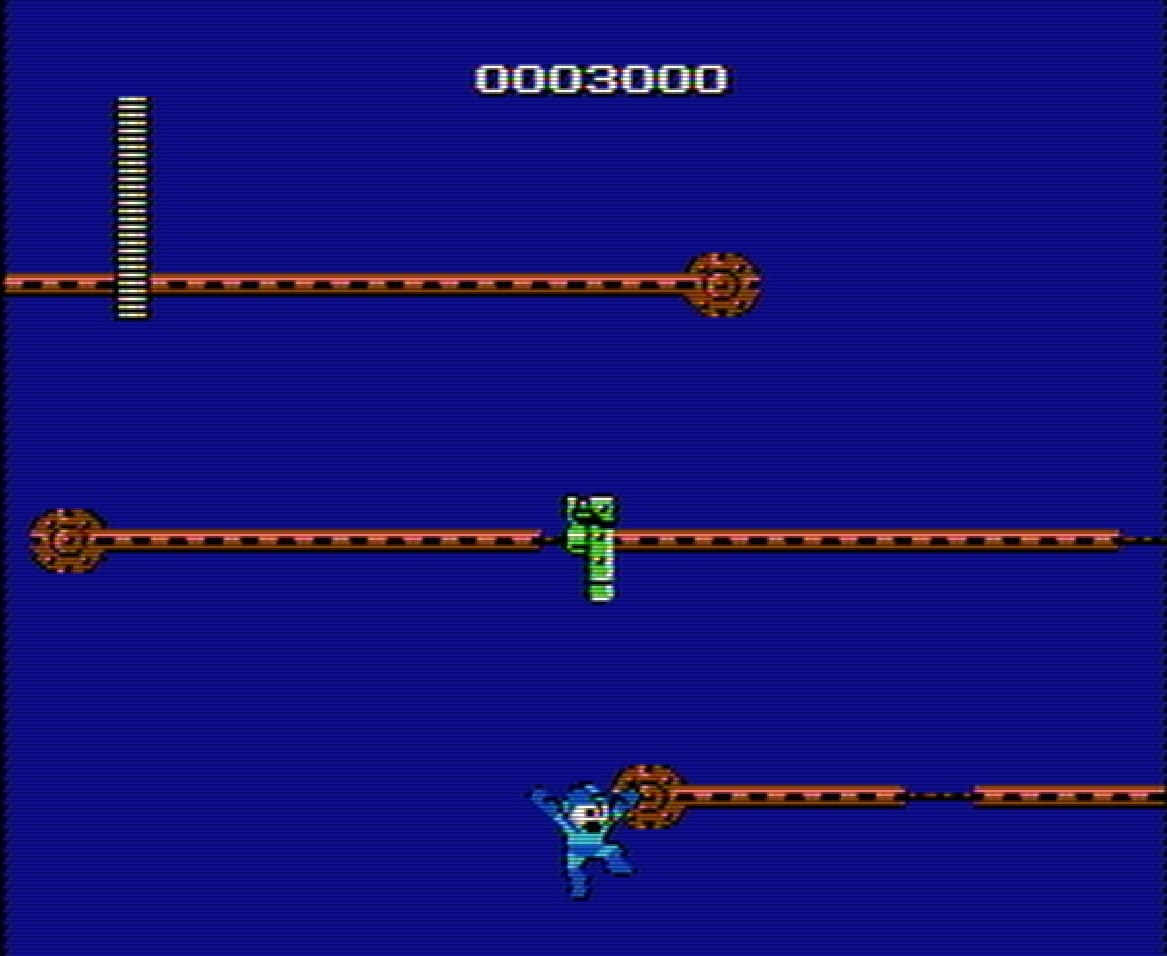
I traded the game in the next day.
In the summer of 2005, I would get into sprite comics like Bob and George and its many contemporaries, which got me more into the world of the classic games — although it did lead me to believe in the Cataclysm Theory, and that Ran Cossack must have been a canon Mega Man character. (I won’t go on these tangents.) This would get me to start editing Mega Man sprites, which got me into pixel art, which was my first step down the path of game development. It also got me to buy another copy of Anniversary Collection. Mega Man became such an object of worship to me that I came to school dressed up as Proto Man for Halloween in 6th grade, complete with a cylindrical homemade Proto Buster my mom helped me make, although I had to make due with no helmet and a blue scarf due to a lack of materials.
Then, in the fall of 2006, a few months into 7th grade, my paternal grandmother died. I had never met this woman due to the fact that she hated my mother, and everything I’d ever heard about her was bad. Suddenly, her death changed everything for my family, and we had to move from my lifelong home in rural Florida to her house in Greenwich, Connecticut to take care of affairs for a year. It was a hard year for me. I had to leave behind my friends — friends who I had bonded with in part over our shared love of Mega Man and Sonic, who I’d inserted into my sprite comics via edited Mega Man sprites. I would still talk to my best friend over the phone, but making new ones was hard for a kid as shy as me. For Christmas that year, I received a copy of Battle Network 6, the final game in the series. In it, Lan, too, had to move away from his hometown, now distant from the friends he had known for five games, and start going to a new school where everything worked a little differently. It resonated. It felt like the stars had aligned.
MegaMan’s arc in 6 was also relatable, as that’s the one where the internet makes something awaken inside him and he becomes a furry.
The ’00s were a magical time to become a Mega Man fan. We had multiple series continuing at the same time — alongside Battle Network and its spinoffs, we had the final few entries of Mega Man X, its sequel series Mega Man Zero, all sorts of ports and remakes, and eventually a pair of tokusatsu-flavored DS era successors: the MetroidVania-ish Mega Man ZX, following up on Zero, and the space-themed Mega Man Star Force, set in Battle Network’s future. As a fan, it was a dream come true. You were never more than a few months away from a new Mega Man game in some form or antother, and most (if not all) of them were good. Truly, we didn’t know how lucky we were.

But… it’s understandable why things dried up as we closed out that decade. While I love and cherish a majority of the dozens of games that were released for the franchise in the ’00s, the market was flooded with Mega Man. Overwhelmed outsiders took one look and assumed that Capcom was just shoveling out crap, coasting off of the fame of the brand from the 8- and 16-bit eras. The GBA section of any game store was invariably filled with like 20 different Mega Man games, most of them baring the Battle Network name. I mean, critics and casual audiences were already growing tired of the iterative classic and X series games in the ’90s, which was why Battle Network was created to freshen things up for a new generation in the first place, and now the fresh revival also had its own mountain of games. For many, it was easier to simply ignore all of it instead of trying to figure out how much of it was any good.
I’ll admit: I didn’t return to Battle Network for years, despite my love of the series. I continued to revisit most of the other Mega Man games on and off, but not Battle Network — or its successor Star Force, for that matter, which lasted into high school for me. Unlike most of the sidescrollers, I can’t beat a Battle Network game in an afternoon, so that probably didn’t help. But I guess on some level I’d also just had my fill after nine games based around the same format. And so had the rest of the world, it seemed. Declining sales led to the cancellation of Star Force 4, robbing the world of its sick as hell premise. The final release— a mildly enhanced DS port of Battle Network 1 with some Star Force content added — never officially left Japan, cementing the image of a failed experiment in the eyes of many onlookers.
But now, here we are, over two decades after the series began. The Legacy Collection is out. It’s breaking sales records for Mega Man as a whole. We’re seeing an outpouring of love for the series around the world. We even got a heartwarming new epilogue chapter for the manga, showing us how Lan and friends are doing as adults. After years of uncertainty, the EXE Sweep is here. And with it, I’ve finally made time to play my first Mega Man game — Mega Man Battle Network 3 — through to the end.
Absence really does make the heart grow fonder.
…Now let’s get those Legends and Star Force collections.
Epilogue: So… which one should you start with?
If you’ve somehow made it to the end of this long article as a series newcomer and wanna know where to start, what’s the verdict? And which versions should you play?
- Battle Network 1? Nope. While it laid the groundwork for the series, the first one’s super clunky in ways that its sequels ironed out.
- Battle Network 2? Maybe the easiest place to start, with big improvements over 1. The biggest caveat here is just that 2 and its insane script are probably the main reason why the Legacy Collection opens with a disclaimer about cultural insensitivity. Just… brace yourself for a few parts of the story.
- Battle Network 3? One of my favorites, but it was also meant to be the end of the series, which is reflected by both its story and its difficulty spikes. Some annoying sections could deter first time players, but it’s well worth playing. (Recommended version: Blue.)
- Battle Network 4? No. Despite being the best seller, BN4 is the low point of the series. It’s bad. Skip it. (If you HAVE to play it? Red Sun, I guess.)
- Battle Network 5? A good one, but also a departure in terms of gameplay, with difficult tactical missions where you take control of an area using multiple Navis. Probably not a good place to start. (Team Colonel is considered “more canon” for focusing on new characters who are important in 6, but I like the Navis in Team ProtoMan better. Maybe look up the version exclusives yourself.)
- Battle Network 6? Possibly the most fun, with tons of freedom to mess around with its cool transformations. But it’s also the finale, wrapping up the story while also having Lan move to a new town for a change of pace. If you really only have time to play one of these games, or if you mainly want to check out the multiplayer, 6 might be the one. Otherwise, I think you’ll get more out of it if you play some of the others first. (I like Cybeast Gregar, but like with 5, you might wanna look up the version exclusive transformations and Navis to see which version’s you like better.)
Happy virus busting.
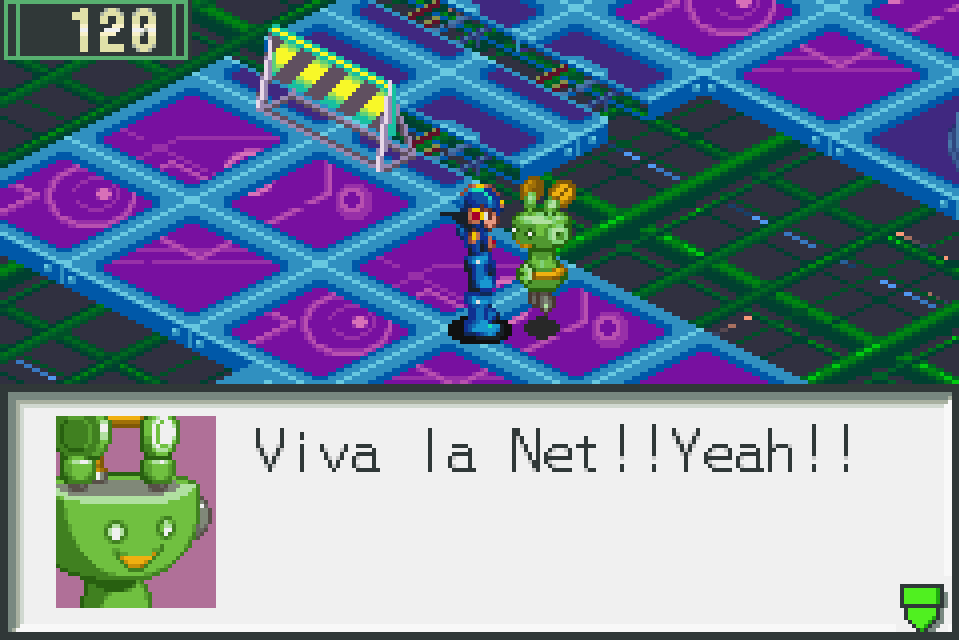

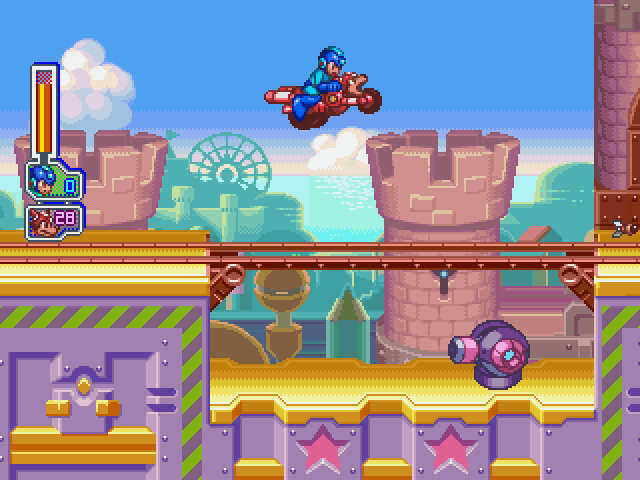
Comments